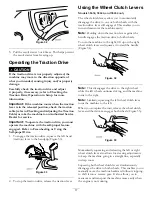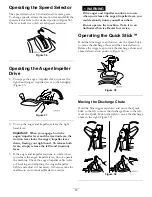
– When practical, remove gas-powered machinery
from the truck or trailer and refuel it on the
ground. If this is not possible, then refuel such
machinery on a trailer with a portable container,
rather than from a gasoline dispenser nozzle.
– Keep the nozzle in contact with the rim of
the fuel tank or container opening at all times,
until refueling is complete. Do not use a nozzle
lock-open device.
– Replace gasoline cap securely and wipe up spilled
fuel.
– If fuel is spilled on clothing, change clothing
immediately.
•
Use extension cords and receptacles as specified
by the manufacturer for all machines with electric
starting motors.
•
Adjust the collector housing to clear gravel or
crushed rock surface.
•
Never attempt to make any adjustments while
the engine is running (except when specifically
recommended by manufacturer).
•
Always wear safety glasses or eye shields during
operation or while performing an adjustment or
repair to protect eyes from foreign objects that may
be thrown from the machine.
Operation
•
Do not put hands or feet near or under rotating parts.
Keep clear of the discharge opening at all times.
•
Exercise extreme caution when operating on or
crossing gravel drives, walks, or roads. Stay alert for
hidden hazards or traffic.
•
After striking a foreign object, stop the engine,
remove the ignition key, thoroughly inspect the
machine for any damage, and repair the damage
before restarting and operating the machine.
•
If the machine should start to vibrate abnormally,
stop the engine and check immediately for the cause.
Vibration is generally a warning of trouble.
•
Stop the engine whenever you leave the operating
position, before unclogging the auger/impeller
housing or discharge chute, and when making any
repairs, adjustments or inspections.
•
When cleaning, repairing or inspecting the machine,
stop the engine and make certain the auger/impeller
and all moving parts have stopped. Disconnect the
spark plug wire and keep the wire away from the
plug to prevent someone from accidentally starting
the engine.
•
Do not run the engine indoors, except when starting
the engine and for transporting the machine in or
out of the building. Open the outside doors; exhaust
fumes are dangerous.
•
Exercise extreme caution when operating on slopes.
•
Never operate the machine without proper guards,
and other safety protective devices in place and
working.
•
Never direct the discharge toward people or areas
where property damage can occur. Keep children
and others away.
•
Do not overload the machine capacity by attempting
to clear snow at too fast a rate.
•
Never operate the machine at high transport speeds
on slippery surfaces. Look behind and use care when
operating in reverse.
•
Disengage power to the auger/impeller when
machine is transported or not in use.
•
Use only attachments and accessories approved by
the manufacturer of the machine (such as wheel
weights, counterweights, or cabs).
•
Never operate the machine without good visibility
or light. Always be sure of your footing, and keep a
firm hold on the handles. Walk; never run.
•
Never touch a hot engine or muffler.
Clearing a Clogged Discharge
Chute
Hand contact with the rotating rotor blades inside the
discharge chute is the most common cause of injury
associated with machines. Never use your hand to clean
out the discharge chute. To clear the chute:
•
Shut the engine off !
•
Wait 10 seconds to be sure the rotor blades have
stopped rotating.
•
Always use a cleanout tool, not your hands.
Maintenance and Storage
•
Check all fasteners at frequent intervals for proper
tightness to be sure the machine is in safe working
condition.
•
Never store the machine with fuel in the fuel tank
inside a building where ignition sources are present
such as hot water heaters, space heaters, or clothes
dryers. Allow the engine to cool before storing in
any enclosure.
3




































